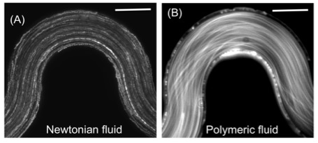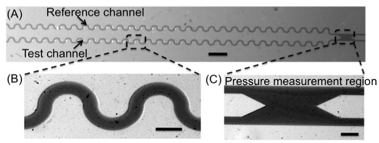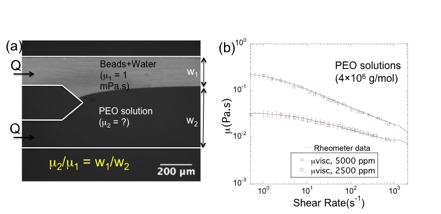www.acsprf.org
Reports: DNI950521-DNI9: Bounds on Energy Dissipation Due to Polymer-Induced Purely Elastic Instabilities in Curved Channel Flows
Siva A. Vanapalli, PhD , Texas Tech University
Polymer solutions are ubiquitously used in enhanced oil recovery (EOR) applications as viscosity modifiers for mobility control. The increased flow resistance offered by polymeric liquids, particularly in high permeability zones improves the reservoir sweeping efficiency resulting in enhanced oil recovery. In a water-wet rock surface, the oil droplets block pore openings and are difficult to dislodge because of interfacial forces. However, by introducing polymeric liquids that exhibit large flow resistance, the pressure drop due to the flowing polymeric liquid can overcome the Laplace pressure gradient associated with the oil droplet, resulting in the displacement of trapped oil. Thus, knowledge of the energy dissipation conferred by flowing polymeric liquids is a principal determinant of the efficacy of enhanced oil recovery applications.
The flow resistance of polymeric liquids is often attributed to their high shear-viscosities. However, in complex geometries such as the reservoir porous media, the polymeric liquid flows through tortuous paths, and literature studies in model geometries have shown that the coupling of the curved streamlines and polymeric elastic stresses can create instabilities in fluid flow, even in the limit of zero Reynolds number (Re). For example, as shown in the curved channel fabricated in the PI's laboratory (see Figure 1), micron-sized beads mixed in a Newtonian fluid yield laminar flow streamlines, however the same beads dispersed in a polymeric fluid yield chaotic streamlines. Thus, it is possible that not only the high viscosity of polymeric liquids, but also purely elastic instabilities in curvilinear geometries could lead to enhanced flow resistance during polymer flooding operations in EOR applications. Despite recent advances in the understanding of elastic instabilities, knowledge of the frictional resistance induced by polymer instabilities in curvilinear channel (Dean) flows and its dependence on polymer parameters (molecular weight and concentration) is lacking. If this knowledge becomes available, then it could be used to predict the performance of polymers during polymer flooding operations. The framework being developed in this work could also be used to test newly designed 'green' polymers for their frictional resistance before field implementation.
To quantify the contribution of polymer-induced elastic instabilities to the frictional resistance, we microfabricated a device containing serpentine microchannels as a model for porous media as shown in Fig. 2. To determine the mean flow resistance as well as fluctuations due to polymer-induced elastic instabilities requires instantaneous measurement of the pressure drop as a function of the flow rate in the microfabricated device. Conventional methods to measuring pressure drop, by attaching bulky pressure gauges are not ideal at the microscale, because of large dead volumes and compliance in tubing that could lead to long response times. Such non-idealities particularly complicate the quantification of fluctuations in flow resistance due to elastic instabilities.
We developed a novel 'comparator' tool that can perform in situ pressure drop measurement on the device, eliminating the need for external pressure sensors. The working principle of the pressure measurement involves two identical channels – the test and reference channel – that are connected downstream to form a region where fluids can be compared (see Figure 3A). If fluids of different viscosity are introduced at equal flow rates, then the laminar fluid-fluid interface shifts. The ratio of the widths of the two streams is proportional to the viscosity ratio of the two fluids.
To test the in situ pressure drop measurement technique, we measured the pressure drop produced by high molar mass polyethylene oxide solutions by locating the position of the interface. This pressure drop data was converted into apparent viscosity and compared with that obtained from a conventional rheometer. Our results in Fig. 3B show excellent agreement, indicating that the comparator tool can be used to measure the pressure drop due to flowing polymer fluids. Because we can track the interface position as a function of time, we are also able to measure the fluctuations in flow resistance.
Given that our tool is capable of sensitively measuring the flow resistance, the next steps in the project are to implement our technique into the serpentine channel geometry and quantify the flow resistance due to elastic instabilities as a function of polymer molar mass and concentration.
The ACS PRF Doctoral Investigator Grant had a significant impact on the PI's career. It led to a new area of research in the PIs laboratory, which otherwise would not have been pursued. The project is currently supporting a graduate student and has partially supported a postdoctoral researcher. Because of this award, the students have been trained in the several areas including microfabrication, fluid mechanics, polymer rheology and microscopy.
Figure 1
Figure 2
Figure 3



